Composite Backscatter Characteristics of Conductive/Dielectric Ships and Sea Surfaces with Breaking Waves under High Sea Conditions
Abstract
1. Introduction
2. Materials and Methods
2.1. Calculation Method of Electromagnetic Scattering from Conducting/Dielectric Targets
EEC Method for Conducting Targets
2.2. Multi-Scale Sea Surface Scattering under Different Sea Conditions
2.2.1. Capillary Wave Phase Perturbation Method for Sea Surface Scattering
2.2.2. Wedge-like Breaking Waves Scattering
2.3. Modified Four-Path Model
- path 1.
- single scattering of the ship;
- path 2.
- forward scattering of the ship and then reflected by the sea surface;
- path 3.
- the reflection field of the sea surface and then scattered by the ship;
- path 4.
- the field reflected from the sea surface and scattered by the ship and then reflected from the sea surface again.
- According to the mirror principle, the latter three equivalent paths are as follows: path 2 is equivalent to I→II→IV, path 3 is equivalent to IV→II→III and path 4 is equivalent to V→II→III→IV.
3. Numerical Results
4. Discussion
- (1)
- The backscattering RCS of the ship decreases due to the existence of the coated dielectric layer, indicating that radar stealth can be achieved by using coated absorbing materials to reduce the signal intensity of the target.
- (2)
- The sea surface scattering dominates for near-vertical incidence, while for small grazing angle incidences, ship scattering is dominant, and the tower scattering peak is visible.
- (3)
- Under high sea conditions, it is crucial to consider the impact of the breaking waves on the scattered echo. The mirror scattering decreases, but the incoherent scattering increases with the increase in wind speed due to the roughness of the sea surface. The backscattering RCS of the sea surface (especially for HH polarization) is enhanced due to breaking wave scattering at small grazing angles. As wind speed increases, the scattering enhancement of breaking waves with small grazing angles causes the tower scattering peak to submerge in the sea background.
- (4)
- The azimuthal variation of the ship scattering shows several peaks at the angle that is perpendicular to the four sides of the ship. When the scattering of the sea surfaces is taken into consideration, the sea surface scattering results in the disappearance of scattering peaks at the bow and stern. When considering the scattering of the sea surface, the scattering peaks at the bow and stern disappear. Additionally, for high sea conditions, the scattering peaks of the target are completely submerged.
5. Conclusions
Author Contributions
Funding
Institutional Review Board Statement
Informed Consent Statement
Data Availability Statement
Conflicts of Interest
References
- Guo, L.; Wei, Y.; Chai, S. A review on the research of composite electromagnetic scattering from target and rough surface. Chin. J. Radio Sci. 2020, 35, 69–84. [Google Scholar]
- Xu, X.; Li, X.; Diao, G. Radar Phenomenological Models for Ships on Time-Evolving Sea Surface; National Defense Industry Press: Beijing, China, 2008. [Google Scholar]
- Linghu, L.; Wu, J.; Wu, Z.; Wang, X. Parallel Computation of EM Backscattering from Large Three-Dimensional Sea Surface with CUDA. Sensors 2018, 18, 3656. [Google Scholar] [CrossRef] [PubMed]
- Yang, T.; Zhao, Y.; Wu, G.; Ren, X. Study on Doppler Spectra of Electromagnetic Scattering of Time-Varying Kelvin Wake on Sea Surface. Sensors 2022, 22, 7564. [Google Scholar] [CrossRef] [PubMed]
- Wu, T.; Wu, Z.; Wu, J.; Jeon, G.; Ma, L. Features of X-Band Radar Backscattering Simulation Based on the Ocean Environmental Parameters in China Offshore Seas. Sensors 2018, 18, 2450. [Google Scholar] [CrossRef] [PubMed]
- Rodriguez, P.; Landesa, M.L. The generalized forward-backward method for analyzing thescattering from targets on ocean-like rough surfaces. IEEE Trans. Antennas Propag. 1999, 47, 961–969. [Google Scholar] [CrossRef]
- Wei, Y.; Zhao, Z.; Qi, C. Iterative Hybrid Method for Electromagnetic Scattering from a 3-D Object above a 2-D Random Dielectric Rough Surface. Prog. Electromagn. Res. 2011, 117, 435–448. [Google Scholar]
- Pan, X.; Sheng, X.; Kong, L. Analysis on electromagnetic environment of an extremely large ship by parallel MLFMA. Equip. Environ. Eng. 2008, 5, 48–52. [Google Scholar]
- Guo, L.; Wang, R.; Wu, Z. Basics Theory and Method for the Scattering from the Random Rough Surface; Science Press: Beijing, China, 2010. [Google Scholar]
- Jin, Y.; Liu, P.; Ye, H. Theory and Method of Numerical Simulation of Composite Scattering from the Object and Randomly Rough Surface; Science Press: Beijing, China, 2008. [Google Scholar]
- Chen, H.; Zhang, M.; Yin, H. Facet-based simulator for bistatic scattering of maritime scene with electrically large ships: Slope Summation Facet Model. Int. J. Remote Sens. 2012, 33, 6927–6941. [Google Scholar] [CrossRef]
- Yan, H.; Chen, Y.; Li, S. A fast algorithm for establishing 3-D scattering center model for ship targets over sea surface using the shooting and bouncing ray technique. J. Radars 2019, 8, 107–116. [Google Scholar] [CrossRef]
- He, Z.; Chen, R. Study on efficient high frequency method of electromagnetic scattering from ships above sea surface. J. Radars 2019, 8, 318–325. [Google Scholar]
- Li, J.; Zhang, M.; Jiang, W.; Wei, P. Improved FBAM and GO/PO Method for EM Scattering Analyses of Ship Targets in a Marine Environment. Sensors 2020, 20, 4735. [Google Scholar] [CrossRef]
- Cui, S.; Wu, Z.; Fang, D. A novel foumula of equivalent edge current for calculating RCS of polyhedral structure. J. Microw. 1997, 13, 20–26. [Google Scholar]
- Michaeli, A. Elimination of Infinities in Equivalent Edge Currents, Part I: Fringe Current Components. IEEE Trans. Antennas Propag. 1986, 34, 912–918. [Google Scholar] [CrossRef]
- Li, J.; Yu, D.; Deng, F.; Zhu, G. UTD solution for the diffraction by an anisotropic impedancewedge at arbitrary skew incidence: Numerical matching method. Opt. Express 2011, 19, 23751. [Google Scholar] [CrossRef] [PubMed]
- Yu, D.; He, S.; Fu, S.; Zhu, G.; Yin, H.; Wang, C. Electromagnetic scattering from targets coated with thin layer of isotropic dielectric based on PO-EEC method. Syst. Eng. Electron. 2012, 34, 2428–2432. [Google Scholar]
- Monahan, E.C.; Muircheartaigh, I. Optimal power-law description of oceanic whitecap coverage dependence on wind speed. J. Phys. Oceanogr. 1980, 10, 2094–2099. [Google Scholar] [CrossRef]
- Schroeder, L.; Grantham, W.; Mitchell, J.; Sweet, J. SASS measurements of the, -band radar signature of the ocean. IEEE J. Ocean. Eng. 1982, 7, 3–14. [Google Scholar] [CrossRef]
- Plant, W.J. Microwave sea return at moderate to high incidence angles. Waves Random Complex Media 2003, 13, 339–354. [Google Scholar] [CrossRef]


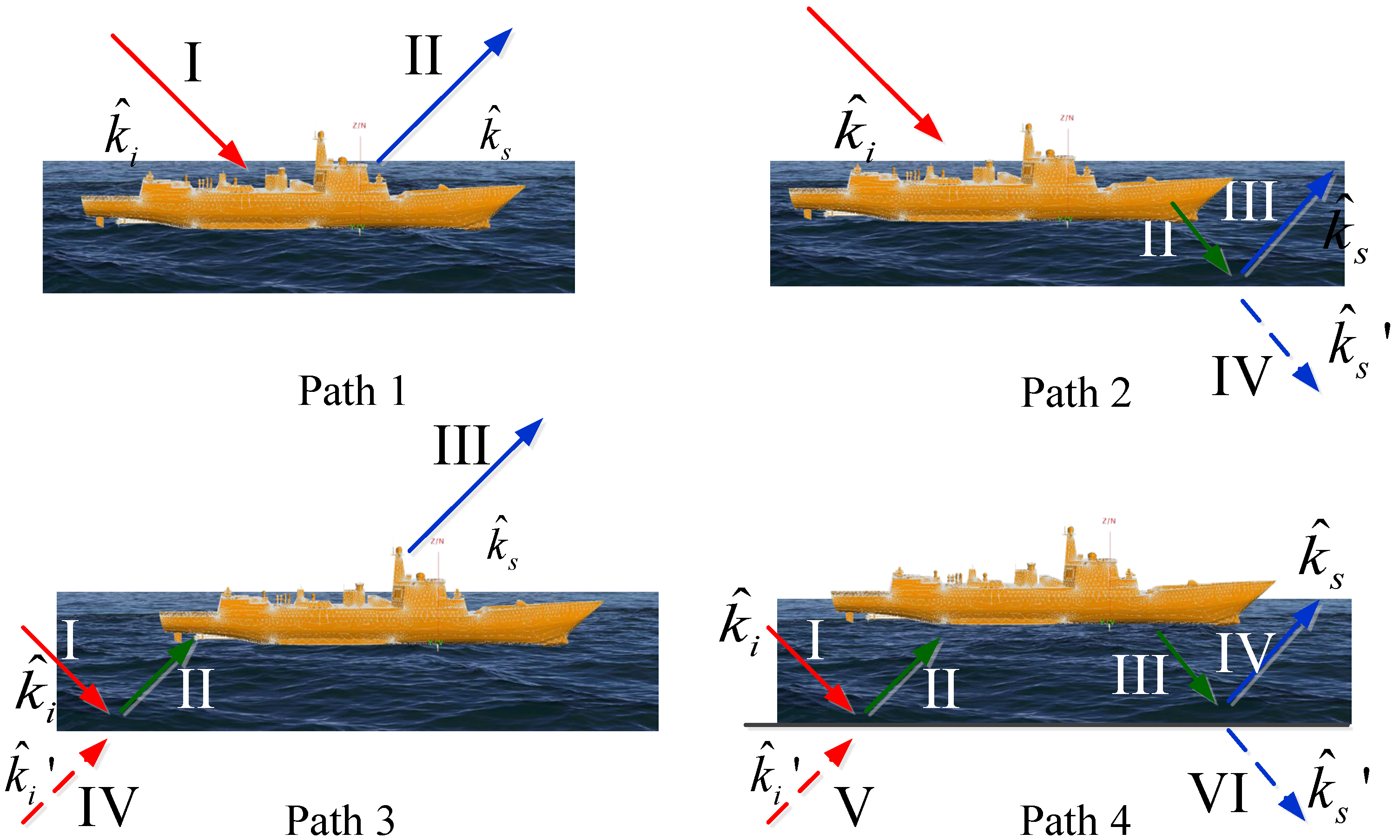

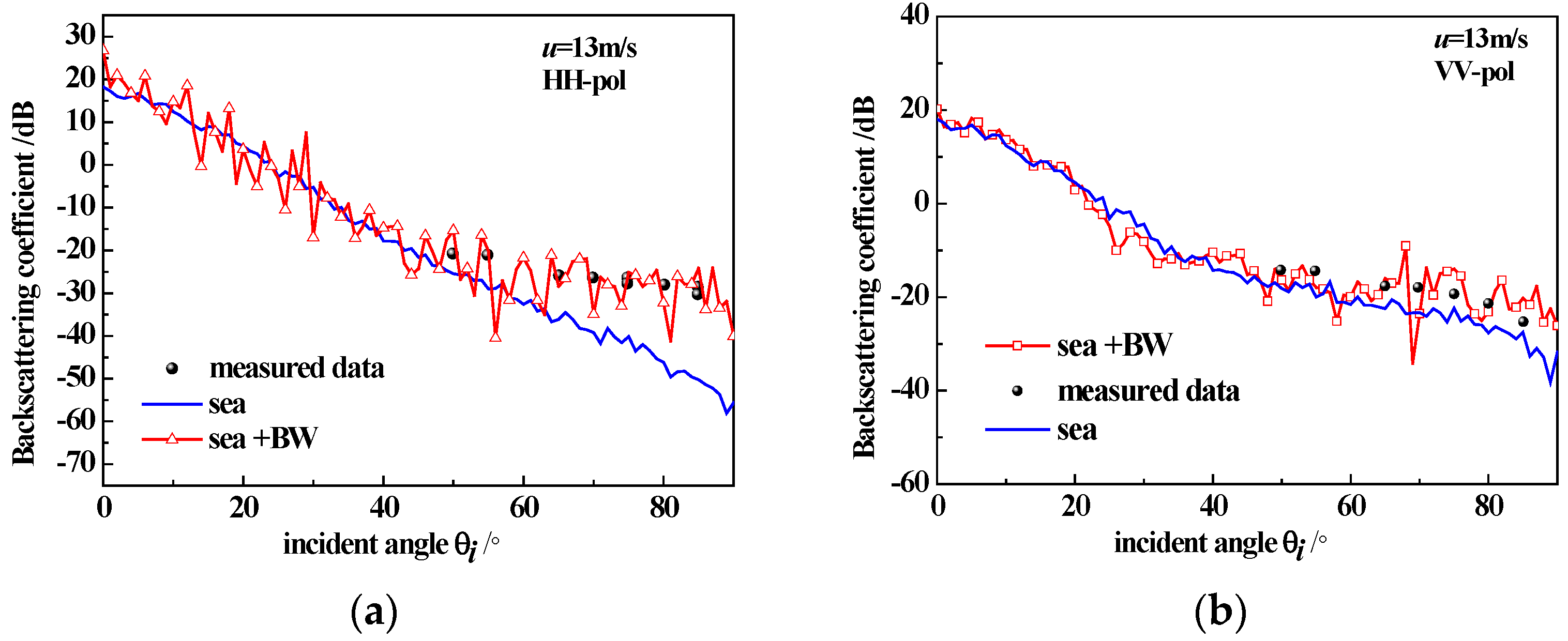
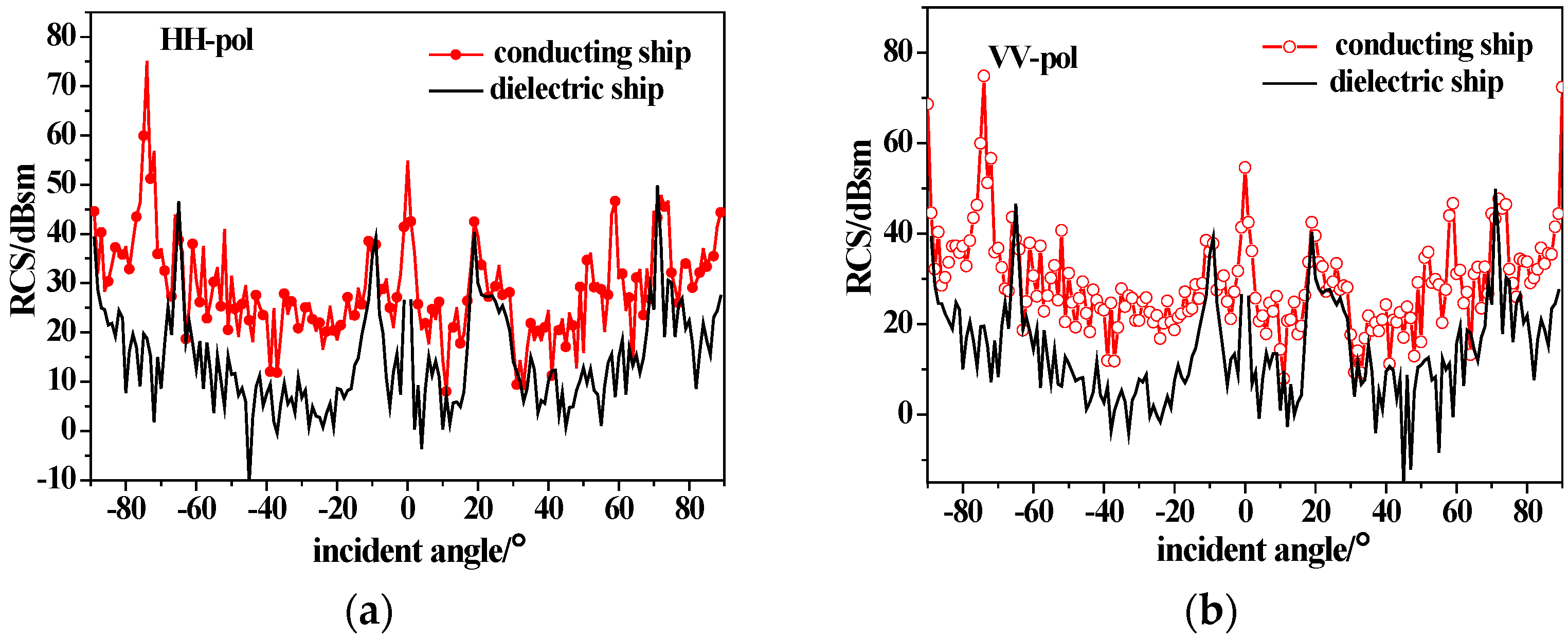

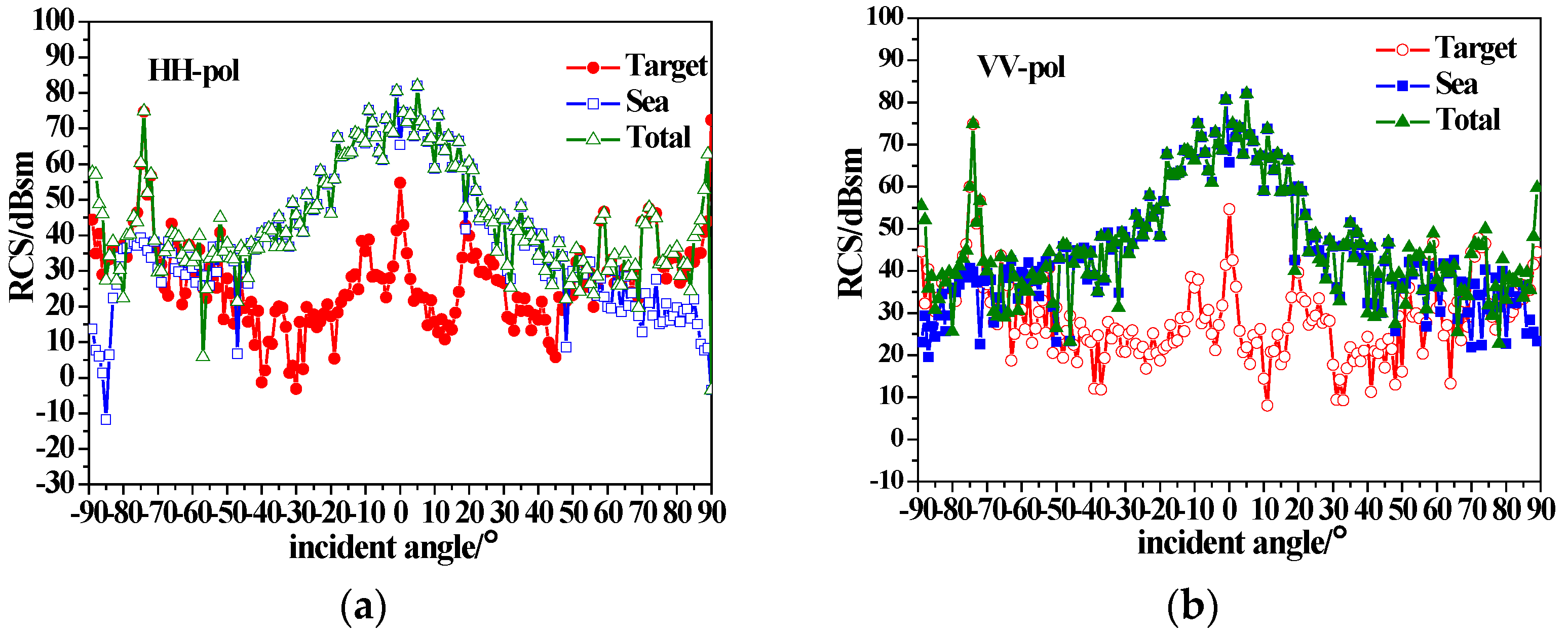


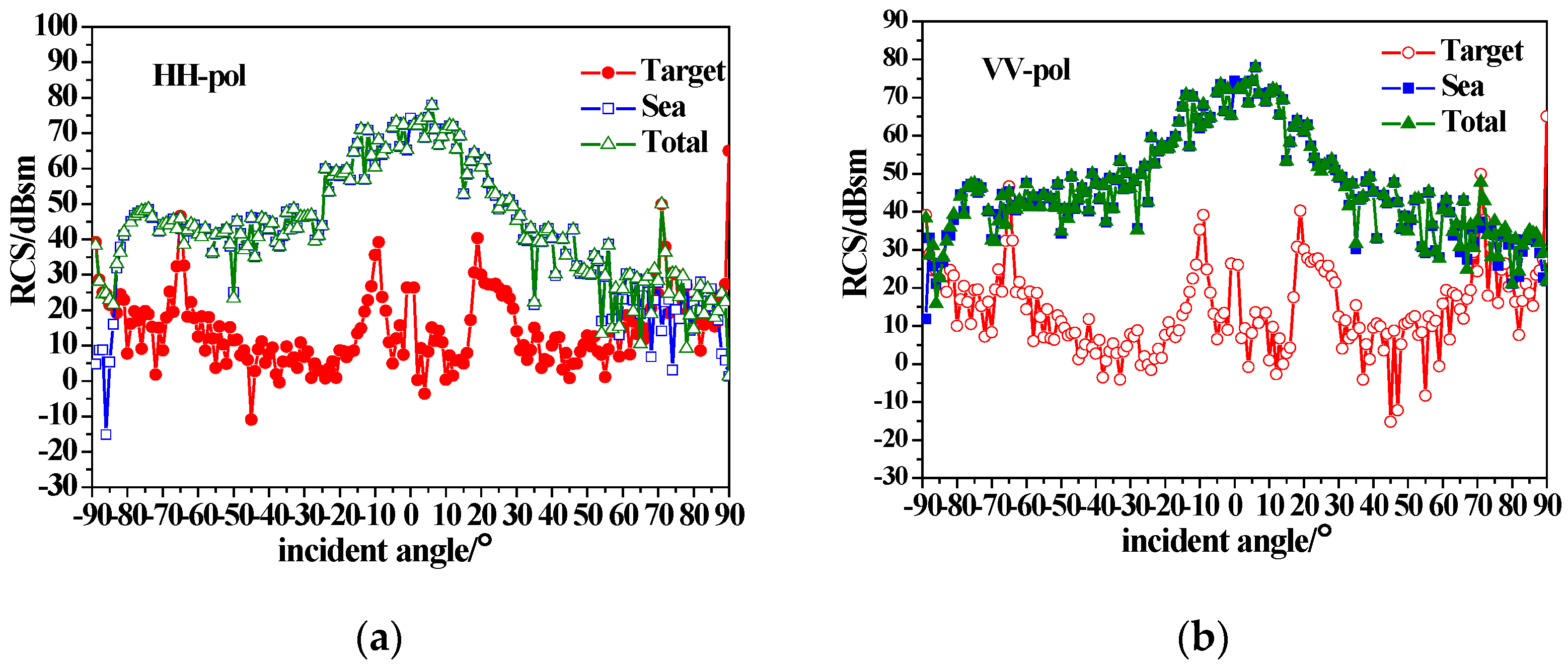
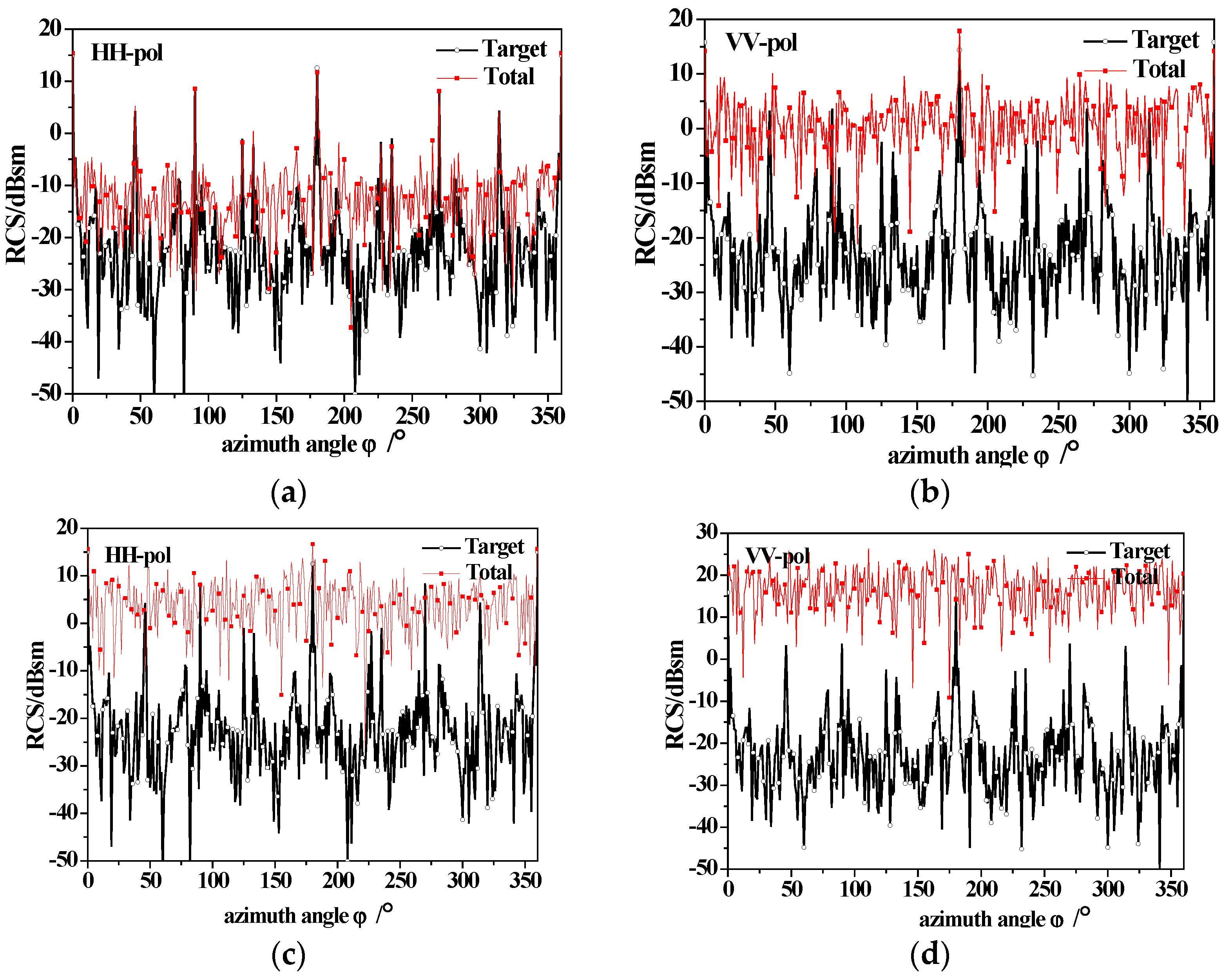
Disclaimer/Publisher’s Note: The statements, opinions and data contained in all publications are solely those of the individual author(s) and contributor(s) and not of MDPI and/or the editor(s). MDPI and/or the editor(s) disclaim responsibility for any injury to people or property resulting from any ideas, methods, instructions or products referred to in the content. |
© 2023 by the authors. Licensee MDPI, Basel, Switzerland. This article is an open access article distributed under the terms and conditions of the Creative Commons Attribution (CC BY) license (https://creativecommons.org/licenses/by/4.0/).
Share and Cite
Zhang, X.; Su, X.; Wu, Z. Composite Backscatter Characteristics of Conductive/Dielectric Ships and Sea Surfaces with Breaking Waves under High Sea Conditions. Sensors 2023, 23, 4904. https://doi.org/10.3390/s23104904
Zhang X, Su X, Wu Z. Composite Backscatter Characteristics of Conductive/Dielectric Ships and Sea Surfaces with Breaking Waves under High Sea Conditions. Sensors. 2023; 23(10):4904. https://doi.org/10.3390/s23104904
Chicago/Turabian StyleZhang, Xiaoxiao, Xiang Su, and Zhensen Wu. 2023. "Composite Backscatter Characteristics of Conductive/Dielectric Ships and Sea Surfaces with Breaking Waves under High Sea Conditions" Sensors 23, no. 10: 4904. https://doi.org/10.3390/s23104904
APA StyleZhang, X., Su, X., & Wu, Z. (2023). Composite Backscatter Characteristics of Conductive/Dielectric Ships and Sea Surfaces with Breaking Waves under High Sea Conditions. Sensors, 23(10), 4904. https://doi.org/10.3390/s23104904





